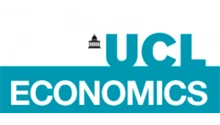UK high streets vary in both range and affordability. From Greggs’ national footprint to the dominance of Pret A Manger in London, the location and prices of different shops reveal the country’s economic, political and cultural divides.
High streets are among Britain’s most frequented public spaces: places to shop, work and relax – even to vote and/or protest. They also trace the geographies of both prices and politics.
Delineating Britain’s cultural geographies is a national obsession. Whether it’s the North–South divide, red wall versus blue wall, or maps of variations in how the word ‘scone’ is pronounced, there’s a long tradition of carving up the UK map in unusual ways.
Looking at the location of coffee shops is yet another way to do this. Researchers at Sheffield Hallam University have divided the country according to its café chains. Doing so reveals a ‘Greggs Britain’ and a ‘Pret Britain’ (see Figure 1).
Figure 1: Greggs Britain and Pret Britain
Notes: Every Pret A Manger and Greggs location in the UK.
Source: Author’s illustration with Pret A and Greggs data
Pret A Manger (or ‘Pret’) operates almost 475 stores across the UK. With its flatbreads and coffee subscriptions, over half of the upmarket grab-and-go chain’s branches are in London, with the capital hosting 271 Prets – roughly 0.5 per square mile. No other city comes close. Manchester has 14 and Edinburgh and Birmingham have just ten each. And outside the country’s metropolitan cores, Pret vanishes almost altogether.
Greggs, by contrast, is ubiquitous. With over 2,500 locations, it spans high streets, retail parks and petrol stations. The chain, founded in 1939 in Tyneside, has its deepest roots in the North East but it has spread widely over the years. It recently completed its geographical conquest, reaching Cornwall with four new stores (although it still won’t sell a pastythere, avoiding clashes with the regional treasure).
Together, the two lunch spots draw a culinary map of Britain’s economic and regional divides – Pret for London and Greggs for the rest.
Regional pricing: sausage rolls and pints
Looking at the location of different shops can help us to map modern economic identity. But to go deeper, we need to take a look inside.
Most national chains quietly adjust prices based on location. Rents, wages and other costs shape what customers are charged, even when the product is identical. Figure 2 shows the geography of pricing for two deeply embedded British rituals: a sausage roll and a pint of Guinness.
Figure 2: Guinness and sausage roll prices
Source: Author’s illustration using Wetherspoons and Greggs data
The Greggs vegan sausage roll – which stormed social media when it was launched in 2019 – has become a cultural symbol. Its price ranges modestly, typically costing between £1.20 and £1.45. But those few pence mark a subtle shift: venture into central London and the bill ticks up.
Looking at Guinness reveals a starker divide. Using data sourced from Wetherspoons menus across the UK, a pint of Guinness ranges from £2.59 in Peterlee (County Durham), Wath-upon-Dearne (South Yorkshire) and Batley (West Yorkshire) to £6.66 at the Moon Under Water in Westminster.
Strip out airports (where very high prices skew the numbers) and the 20 most expensive pints are all in London. Wetherspoons pubs are not known for their atmosphere or frills, but even they must charge differentially when doing business in the capital.
Electoral bakeries
The economic geography of retail can also help to explain how people vote. Ahead of the 2024 general election, the Economics Observatory analysed the electoral landscape of the UK’s shopfronts, tracing the political contours of the country via its grocery chains.
It may sound reductive at first, but these shopping-based stereotypes hold surprisingly well. Waitrose – which is associated with affluence, provincial liberalism and neatly arranged compostable packaging – was a Conservative bastion before last year’s election. In 2019, the Tories held 76% of constituencies that contained a Waitrose, but just 46% of those without.
Figure 3: 2024 election results by presence of supermarket
Source: Author’s illustration with data from Geolytix and House of Commons Library. Hexagonal basemap from Automatic Knowledge.
The 2024 election changed the picture. Support for the Conservatives collapsed even in places with a premium supermarket. After the vote, they held just 28% of seats with a Waitrose, and only 13% of those without (52 seats). The interactive tool above presents data for the rest (see Figure 3).
But the most telling high-street indicator of 2024 election wasn’t a supermarket. It was a coffee shop: the Gail’s bakery chain. According to The Economist, Liberal Democrat strategists adopted a novel campaigning approach: to target every town outside London that has a Gail’s. The upmarket bakery, known for its rustic sourdough and almond croissants, has been expanding beyond the capital into affluent southern towns like Amersham, Guildford and Henley.
Figure 4: 2024 election results in constituencies with Gail’s bakeries
Source: Author’s illustration with data from Gail’s, ONS and House of Commons Library
The strategy worked. Of the 43 constituencies outside London with a Gail’s, the Liberal Democrats won the most seats, with 20 (Figure 4). These were typically prosperous, well-educated southern areas, once solidly Conservative. Ed Davey’s party swept these seats, forming a ‘sourdough belt’ across the South of England.
Struggling high streets
Sourdough swings and sausage roll maps are fun to explore. But the UK’s high streets are struggling. According to the Centre for Retail Research, approximately 13,500 stores closed across the country in 2024 – an average of 37 closures per day and a 28% increase on 2023. Of those closures, 7,500 were directly linked to company failures, including several once-strong national chains.
Figure 5: UK stores affected by retail company failure
Source: Centre for Retail Research
Earlier this year, WH Smith announced its departure from the high street after 233 years, selling 480 stores to private equity firm Modella Capital for £76 million. The outlets will continue trading under the new label of ‘TGJones’, but the rebrand marks the end of an era for the household name.
Behind this decline are rising costs and increased online competition. Online retail sales hit a record £127 billion in 2024, as more consumers shifted to internet shopping. Meanwhile, in-person retail faces mounting cost pressures: rent, wages and utility bills are rising while the recent hikes to employers’ national insurance contributions (NICs) will have a disproportionate effect on sectors that rely on low-margin, low-wage employment (such as retail).
The prices and patterns on the UK’s high streets trace its cultural and economic divides, from £2.59 Guinness in Yorkshire to a cluster of Prets in central London. They can even reflect voting behaviour, with the Lib Dems sweeping the sourdough belt of southern towns marked by Gail’s bakeries. With high streets under pressure, this living retail geography is likely to keep changing in ways that are yet to be revealed.
Where can I find out more?
- The new front line of British politics is just lovely: The Economist details the Liberal Democrats’ electoral strategy based on Gail’s bakeries.
- The Greggs-Pret index: a machine learning analysis of consumer habits as a metric for the socio-economic North-South divide in England: Robin Smith and Kristian Haverson (Sheffield Hallam University) algorithmically map ‘northernness’ versus ‘southernness’, using the footprints of Greggs and Pret.
- Who’s gone bust in retail?: a tracker of the shops disappearing from UK streets produced by the Centre for Retail Research.
- Re-creating the platoons of place: policy solutions for the problem of vacant and derelict commercial property in a report from the Create Streets consultancy.
Who are experts on this question?
- Cathy Parker
- Ron Martin
- Andy Pike
- Gillian Bristow









































